Markets
Cotton Prices Drop Amid Rising Stocks, Weak Demand, and Trade Concerns
Cotton prices fell last week as USDA raised production and ending stock estimates. Weak export sales and lower-than-expected U.S. tariffs on China added pressure. China’s weak consumer demand and job market remain concerns, despite planned economic stimulus. Reports of soft demand continue, while strong U.S. production is expected next year, further weighing on the market.
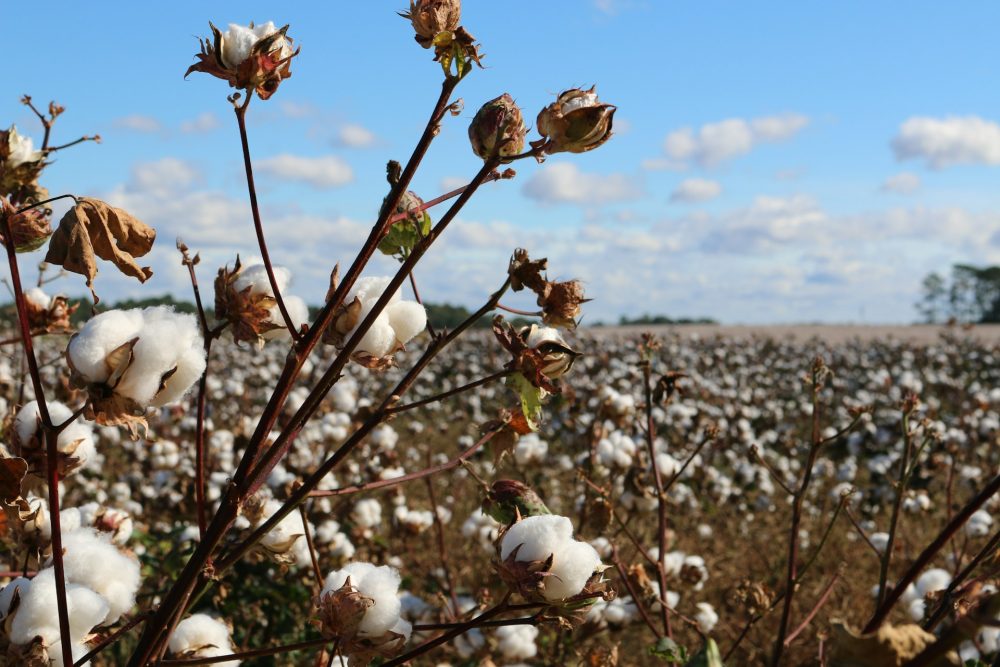
Wheat: The markets were about unchanged last week and the trends are starting to turn down. The USDA reports were not bullish to Wheat as plantings were higher than trade expectations as were world ending stocks estimates. US ending stocks estimates were 798 million bushels, below the average trade guess of 807 million but above what USDA published last month at 795 million. These estimates were considered mildly negative for prices. World Wheat demand has been strong, but there has not been much demand in world markets for US Wheat.
The growing conditions in the US are very good. Reports of very beneficial rains for the Great Plains and Midwest and reports of steady to firm prices quoted in Russia and steady prices Argentina were around and helped keep the US market mostly steady in current ranges. Wheat farmers in the US planted the Winter crops under good conditions. Australia has seen too much rain recently that has downgraded Wheat quality, but Australia still has a very big crop to sell into world markets.
Weekly Chicago Soft Red Winter Wheat Futures

Weekly Chicago Hard Red Winter Wheat Futures
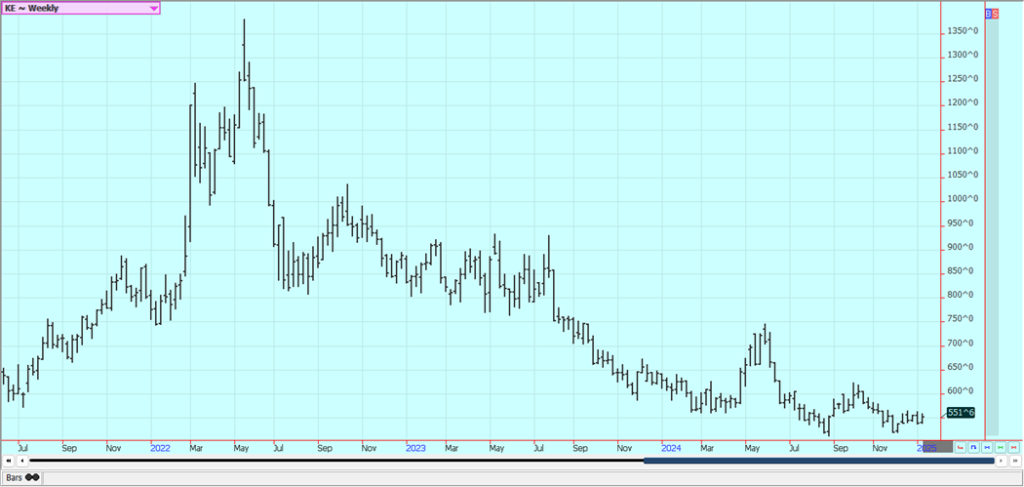
Weekly Minneapolis Hard Red Spring Wheat Futures
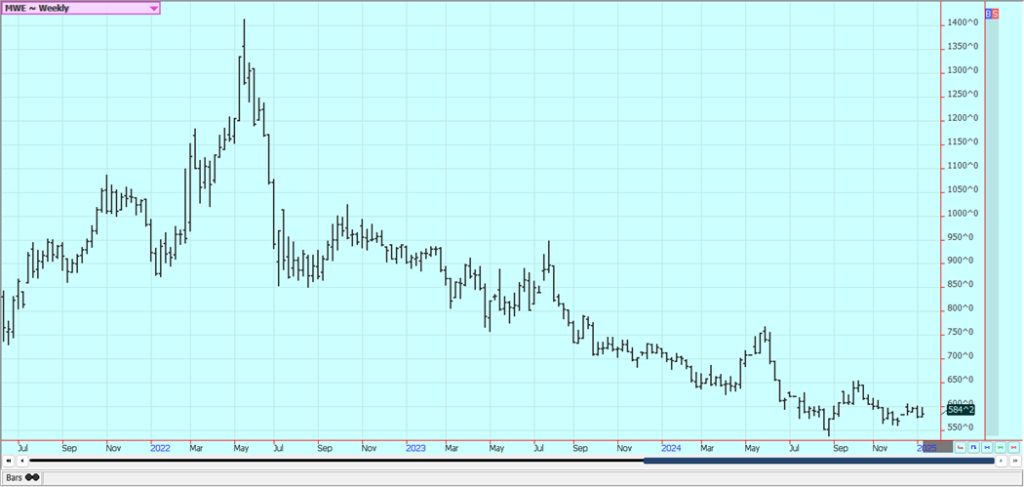
Corn: Corn closed higher last week in response top the USDA production reports. USDA surprised the market by cutting yield estimates by 3.8 bushels per acre and production to just 14.867 billion bushels instead of the 15 billion plus expected by most of the trade. The yield and production estimates were below all trade guesses. US ending stocks were equal to the lowest trade estimate at 1.540 billion bushels. New crop Corn futures did not rally that much as everyone expects farmers to plant more Corn this year due to the big offer expected to develop in the next few weeks in Soybeans from South America. Current crop Corn might have fulfilled upside targets with the price action on Friday.
The export sales report released last week by USDA showed a big reduction in demand and many think that this could become a feature for the market. The export demand in recent weeks has been very strong and it seems like some of the buying is in anticipation of the new presidential regime starting here in January. President Trump has promised new tariffs on goods and services and some buyers may be making purchases now to avoid the potential for the tariff later. It is about to turn very cold in the Midwest so it will get harder for Corn buyers to convince farmers to sell. Oats were a little higher last week.
Weekly Corn Futures
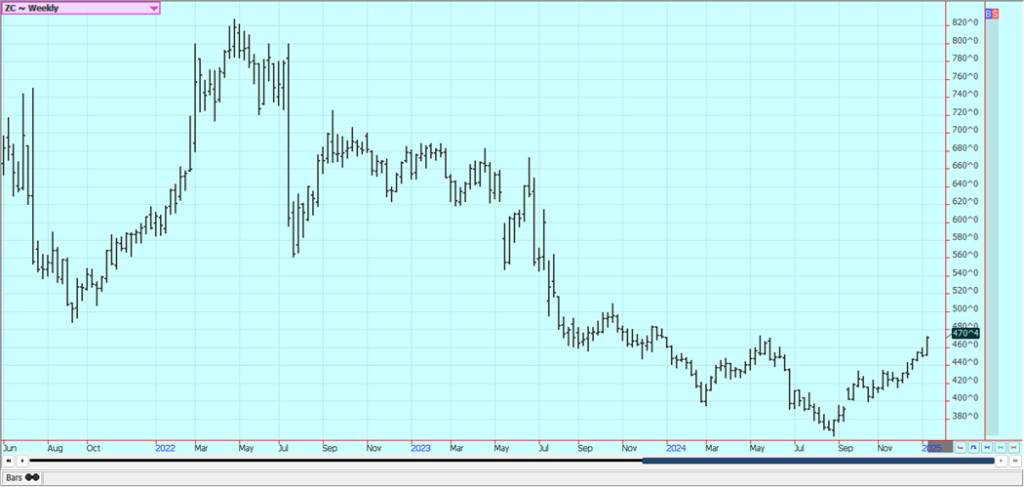
Weekly Oats Futures
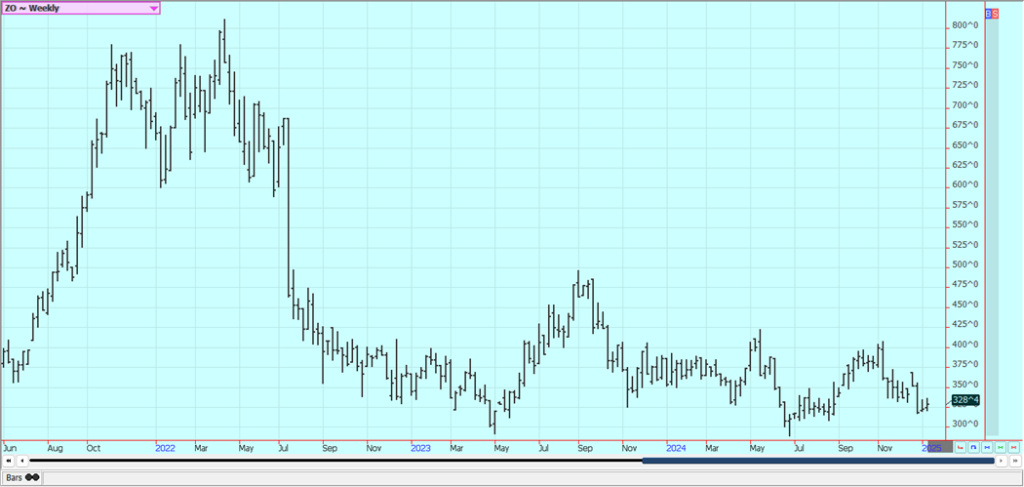
Soybeans and Soybean Meal: Soybeans closed higher in response to the USDA production reports, and the products closed mixed yesterday, with Soybean Meal lower and Soybean Oil higher. Soybean Oil rallied on news that President Biden would issue short term guidance on bio fuels very soon. Soybeans were higher in response to bullish US production estimates released by USDA. It estimated yield a full bushel less than last month and production at 4.36s6 billion bushels.
Ending stocks were estimated at 380 million bushels. Both estimates from USDA were well below the lowest trade guess. Soybeans filled upside targets for many with the price action on Friday, and now ideas are that Soybeans will eventually move significantly lower. World supplies are large now and look to get even bigger with the coming South American harvest. Talk that President Trump wants to stop the use of bio fuels as part of his war on the green economy hurt demand ideas for Soybean Oil. The tariffs that Trump plans to impose could be a detriment to sales of all products.
Brazil looks to produce much more than a year ago and some estimates range as high as 175 million tons for the country. Brazilian farmers have planted what is expected to be a very big crop in central and northern areas of the country. Warm and dry weather in the Midwest last year has hurt US production ideas due to ideas of small and very dry beans in the pods. Demand has been very strong so far this year, in part as many buyers try to get bought ahead of any new tariffs that the Trump administration might impose. Soybeans aare offered cheaper in South America now.
Weekly Chicago Soybeans Futures
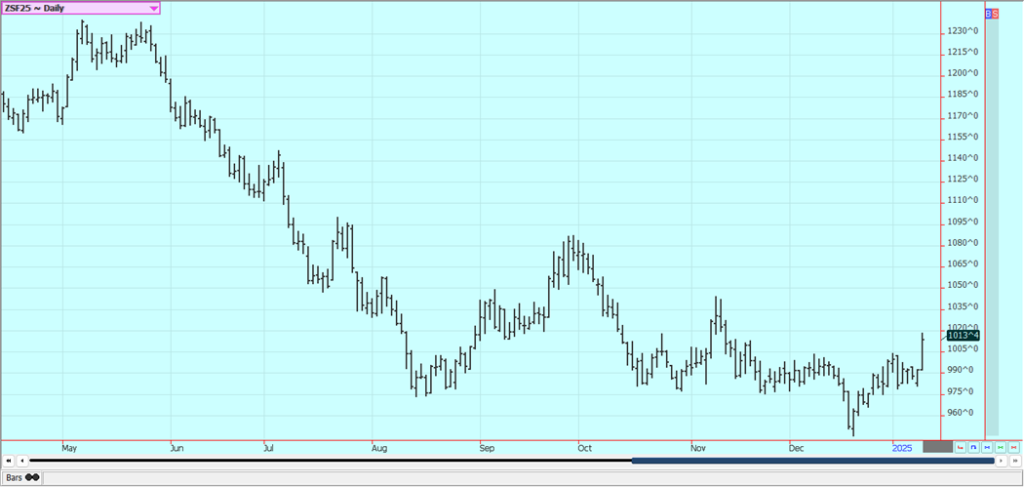
Weekly Chicago Soybean Meal Futures
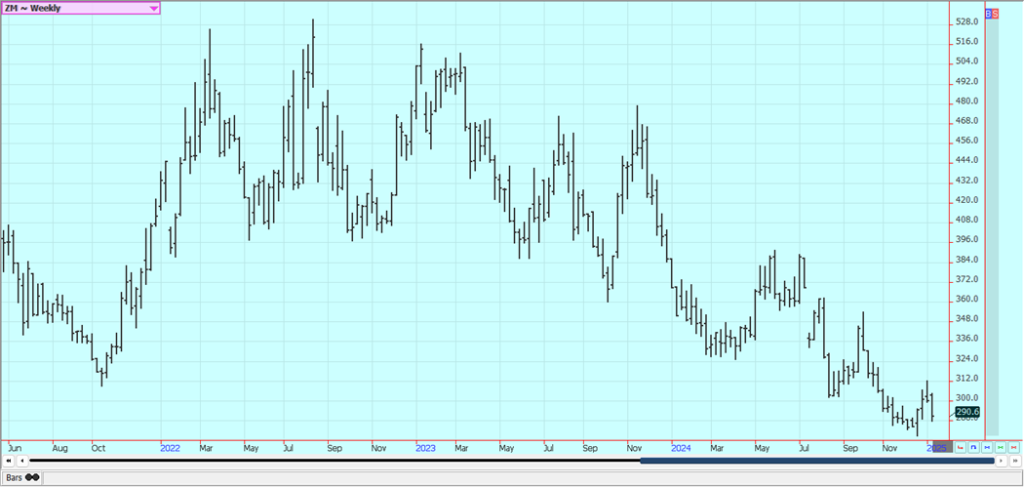
Rice: Rice closed higher last week in continued speculative short covering and some new commercial buying. The trends are up the daily charts. Generally weak Asian prices are still reported. Brazil prices remain strong, but the difference is now less to world buyers as the Real is much lower against the US Dollar. The weekly export sales report showed bad sales.
Weekly Chicago Rice Futures
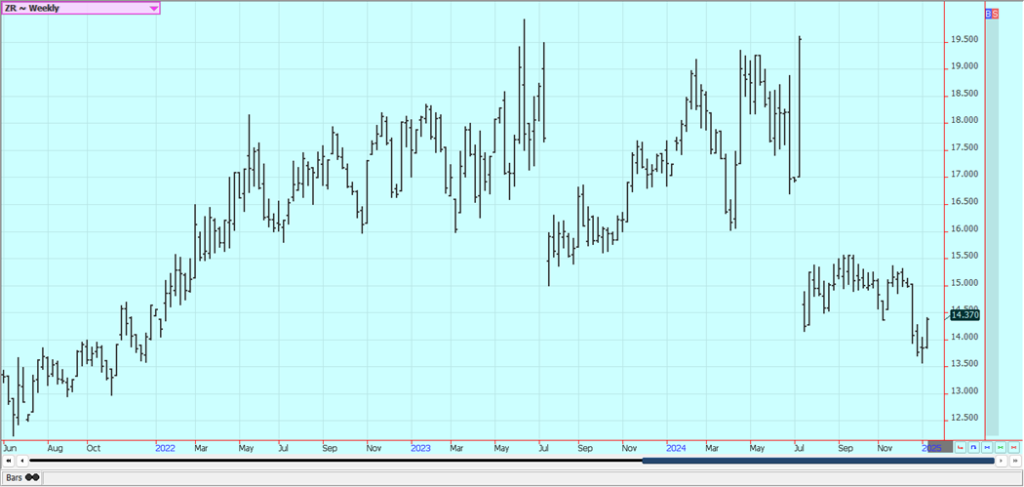
Palm Oil and Vegetable Oils: Palm Oil was slightly lower last week. But closed well off the lows of the week on MPOB data that showed reduced inventories for the third straight month, but there is still concern about the Indonesian fuel program. Indonesia wants to use a blend of 40% of Plam Oil in its gasoline mixtures, but this has proved to be expensive and might need to be reduced and allow for increased exports.
Demand from China has not been good and demand from India has been reduced. Ideas of weaker production caused by too much rain and reports of good demand provided support. Chart trends are down. Canola was higher and the market seems to have finally pushed through the December highs in part due to the bullish USDA reports. The harvest is over in Canada and the crops are locked away in the bin. Producers will try to wait for higher prices before selling much, especially with the cold weather in place now.
Weekly Malaysian Palm Oil Futures:
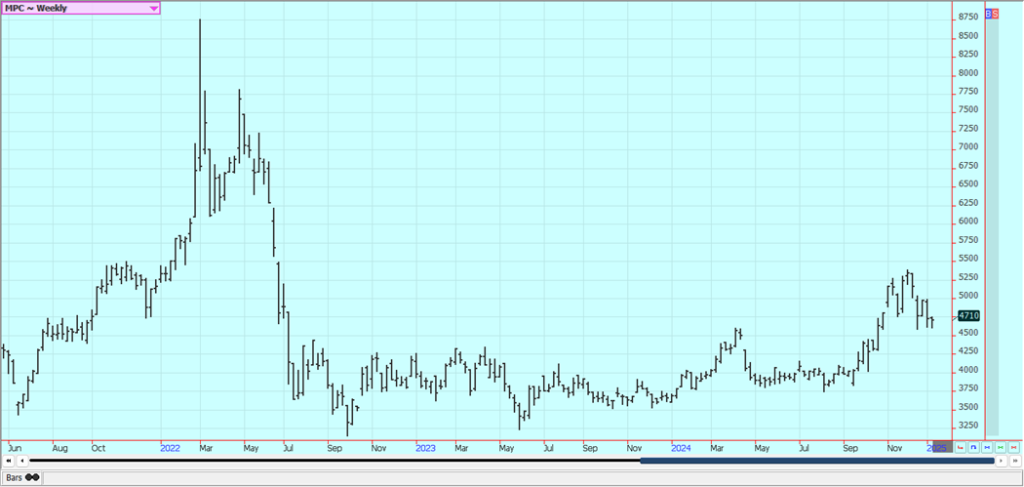
Weekly Chicago Soybean Oil Futures
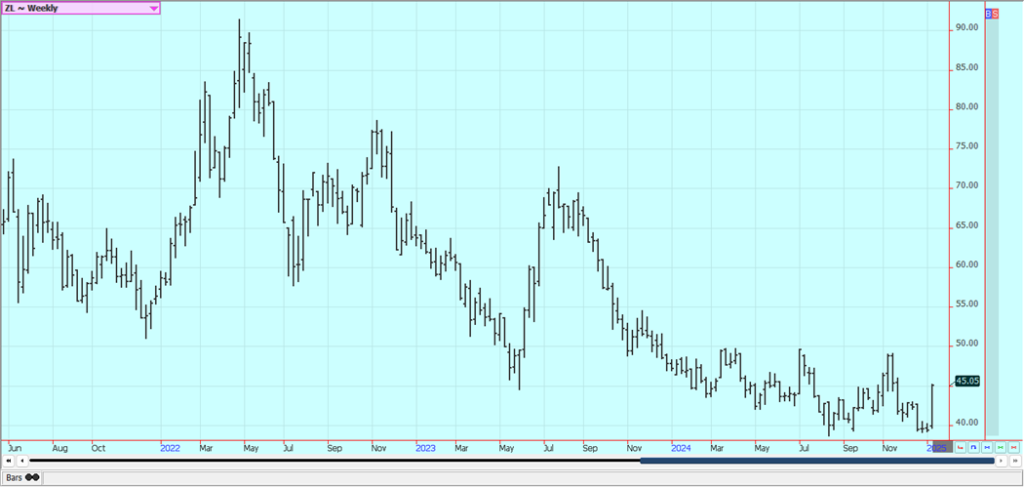
Weekly Canola Futures
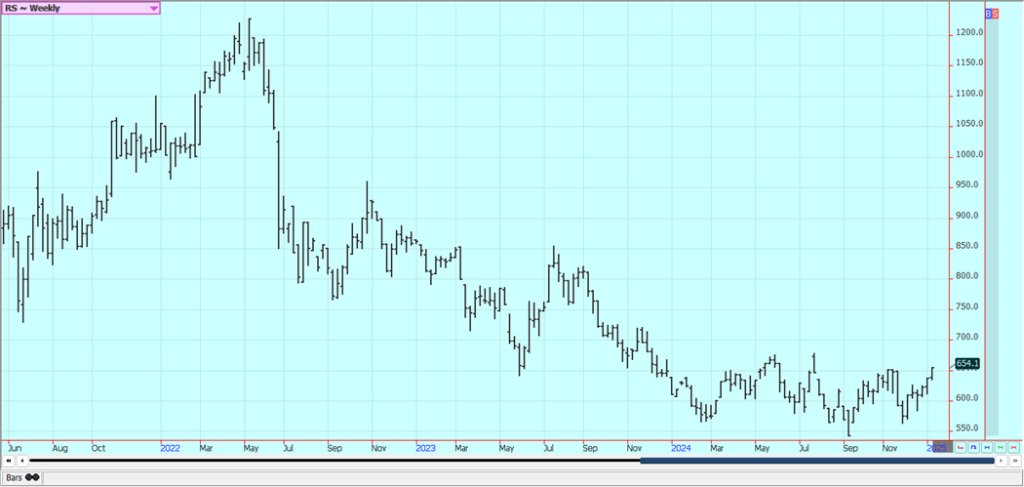
Cotton: Cotton was lower last week after USDA increased cotton production and ending stocks estimates for cotton on Friday. The weekly cotton export sales report did not show strong cotton sales. Cotton selling has come from news that Trump will impose some big tariffs on China, but the tariffs posted were not as high as he had threatened before during the campaign.
China has big problems with its domestic economy with consumer buying interest not strong and many people not working. The government has said it will take stimulus measures for the economy there next year. There are still reports of weaker cotton demand potential against an outlook for good US cotton production in the coming year.
Weekly US Cotton Futures
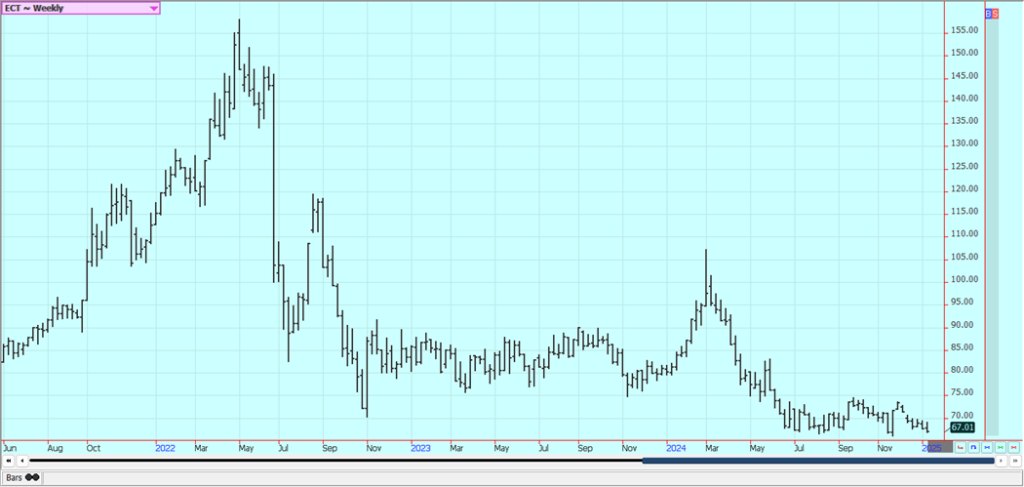
Frozen Concentrated Orange Juice and Citrus: FCOJ closed lower last week and trends are turning down on the daily charts as more cold weather invaded the eastern half of the country but should not harm Florida growing areas. The short term supply scenario remains very tight as USDA maintained its Florida production estimate at 12 million boxes and estimated US production at 60.3 million boxes from 60.6 million in its previous estimate.
The market remains well supported in the longer term based on forecasts for tight supplies in Florida. The reduced production appears to be mostly at the expense of the greening disease and some extreme weather seen in the last couple of years. There are no weather concerns to speak of for Brazil or Florida right now.
Weekly FCOJ Futures
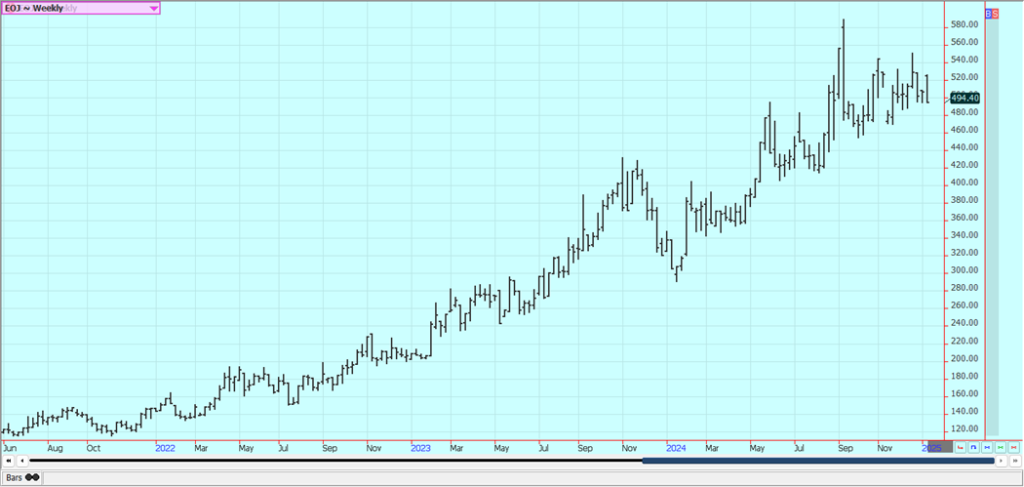
Coffee: New York was higher and London was near unchanged last week as the market looked for more farm selling. Tight Arabica availability went against tight Robusta availability as the harvest has stalled in Vietnam due to too much rain. The rains are also hurting the quality of the harvest as it is more difficult to dry and store the beans correctly.
Reports of reduced offers from Brazil on weather induced short crops continue and there are also reports of too much rain in parts of Central America damaging crops there. Conditions are now good in Brazil as it has been raining. There are reports from Brazil that producers are selling again as the Real has weakened and producers are now making record money in Real terms.
Weekly New York Arabica Coffee Futures
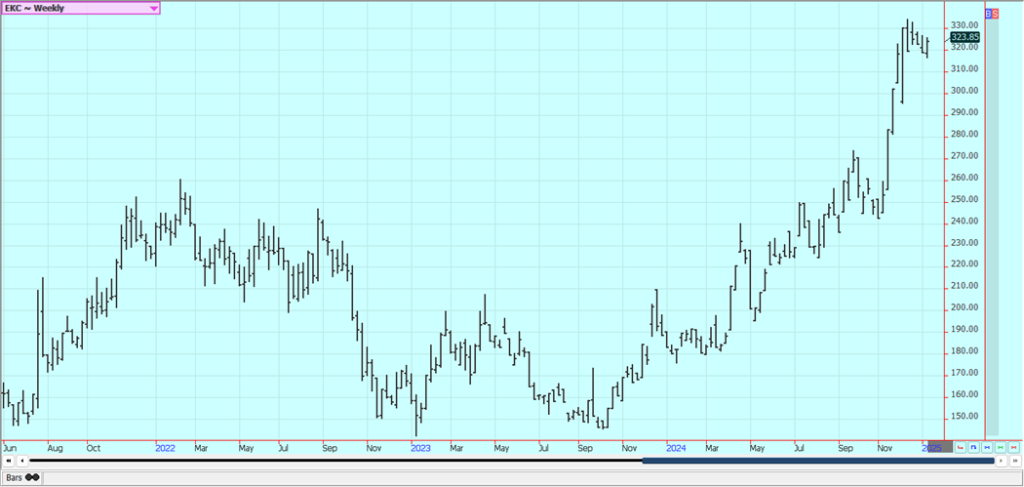
Weekly London Robusta Coffee Futures
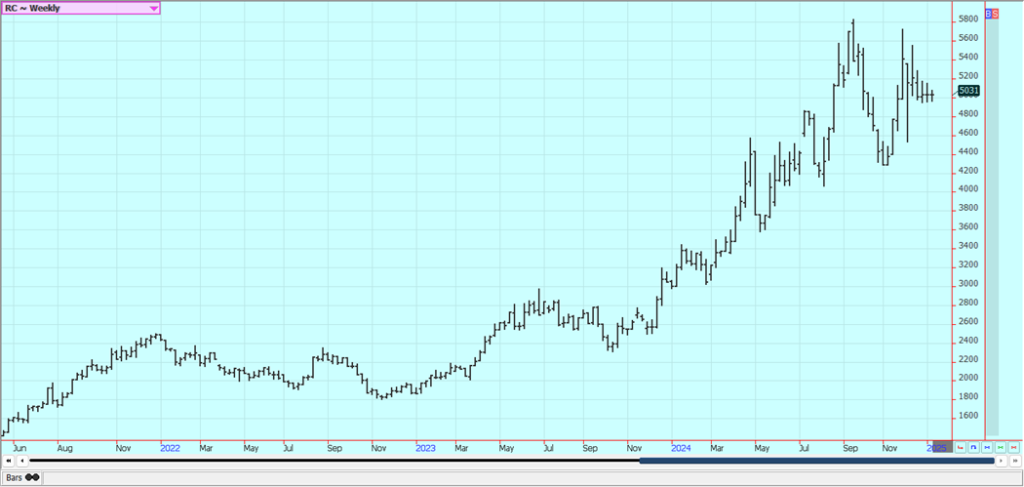
Sugar: New York and London were a little lower last week. The Brazilian Real has been very weak lately to encourage sales and help keep pressure on prices. Trends are mixed in both markets on the daily charts and on the weekly charts.
Indian and Thai mills are expecting strong crops of cane. Supplies available to the market could be less in the next six months due to adverse growing conditions seen in Brazil during the production period. Total Brazil production has been affected by drought seen earlier in the year and the fires that destroyed crops in some areas.
Weekly New York World Raw Sugar Futures
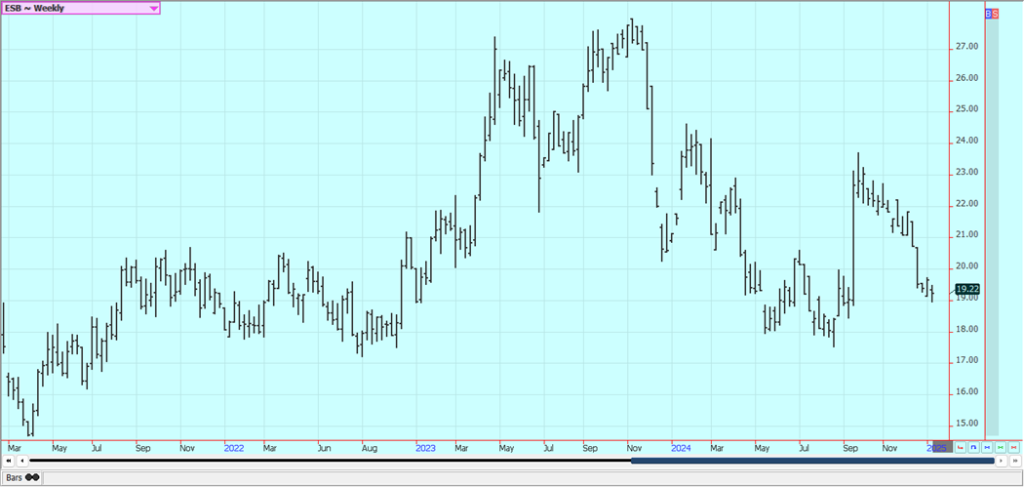
Weekly London White Sugar Futures
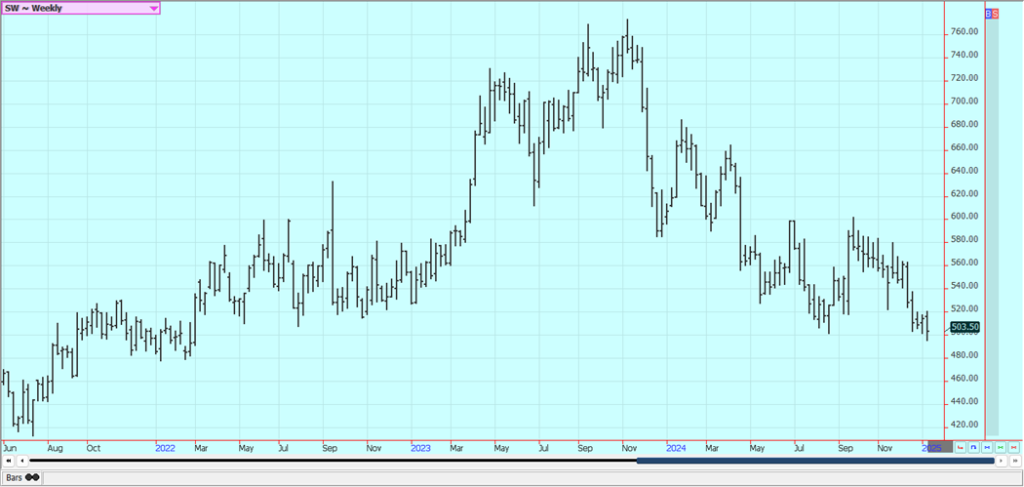
Cocoa: New York and London closed lower last week, but both markets held to the recent weekly trad-ing range. There is talk that production will be short of demand for the fourth year in a row. Chart trends are tuning down in both markets on the daily charts.
Producers in Ghana and in Ivory Coast have been fighting against too much rain that has made it hard to harvest and deliver crops. It has been very dry in West Africa lately. The trade also noted ICE-certified cocoa stocks have been rising of late, but that overall cocoa supply is set to remain sharply constrained for several seasons due to structural prob-lems in Ivory Coast and Ghana.
Weekly New York Cocoa Futures
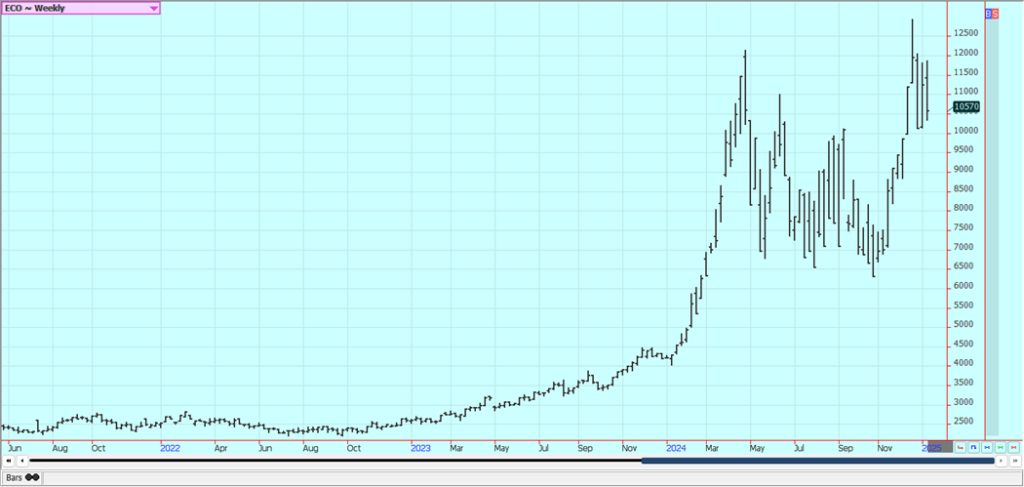
Weekly London Cocoa Futures
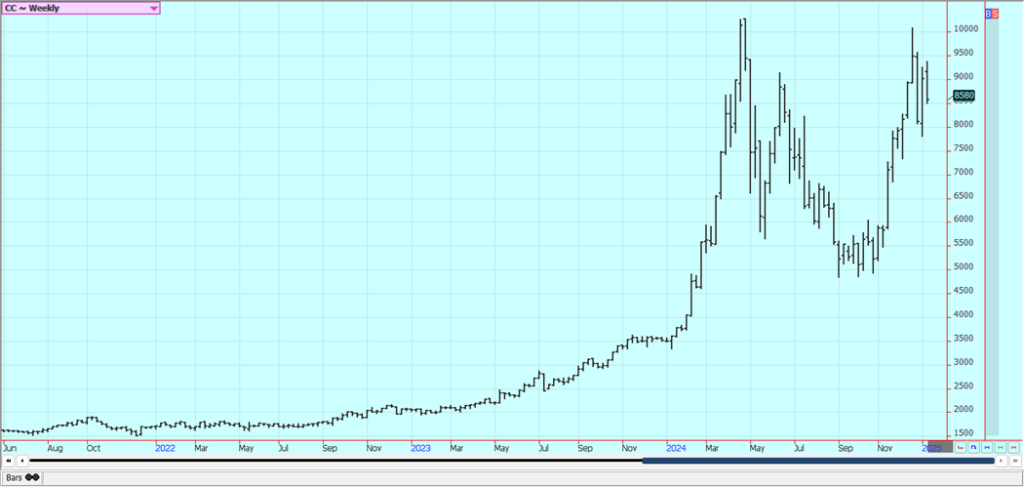
__
(Featured image by Trisha Downing via Unsplash)
DISCLAIMER: This article was written by a third party contributor and does not reflect the opinion of Born2Invest, its management, staff or its associates. Please review our disclaimer for more information.
This article may include forward-looking statements. These forward-looking statements generally are identified by the words “believe,” “project,” “estimate,” “become,” “plan,” “will,” and similar expressions, including with regards to potential earnings in the Empire Flippers affiliate program. These forward-looking statements involve known and unknown risks as well as uncertainties, including those discussed in the following cautionary statements and elsewhere in this article and on this site. Although the Company may believe that its expectations are based on reasonable assumptions, the actual results that the Company may achieve may differ materially from any forward-looking statements, which reflect the opinions of the management of the Company only as of the date hereof. Additionally, please make sure to read these important disclosures.
Futures and options trading involves substantial risk of loss and may not be suitable for everyone. The valuation of futures and options may fluctuate and as a result, clients may lose more than their original investment. In no event should the content of this website be construed as an express or implied promise, guarantee, or implication by or from The PRICE Futures Group, Inc. that you will profit or that losses can or will be limited whatsoever. Past performance is not indicative of future results. Information provided on this report is intended solely for informative purpose and is obtained from sources believed to be reliable. No guarantee of any kind is implied or possible where projections of future conditions are attempted. The leverage created by trading on margin can work against you as well as for you, and losses can exceed your entire investment. Before opening an account and trading, you should seek advice from your advisors as appropriate to ensure that you understand the risks and can withstand the losses.

-

 Cannabis2 weeks ago
Cannabis2 weeks agoUS Hemp Regulation Overhaul Sparks Global Impact
-

 Fintech2 days ago
Fintech2 days agoN26 Hires UBS Executive to Lead Turnaround Amid Regulatory Pressure
-

 Crowdfunding1 week ago
Crowdfunding1 week agoDigital Finance Fosters Inclusivity: Women and Minorities Lead in Italian Equity Crowdfunding
-

 Cannabis4 days ago
Cannabis4 days agoLuxembourg’s Cannabis Paradox: Legal at Home, Restricted Everywhere Else
























